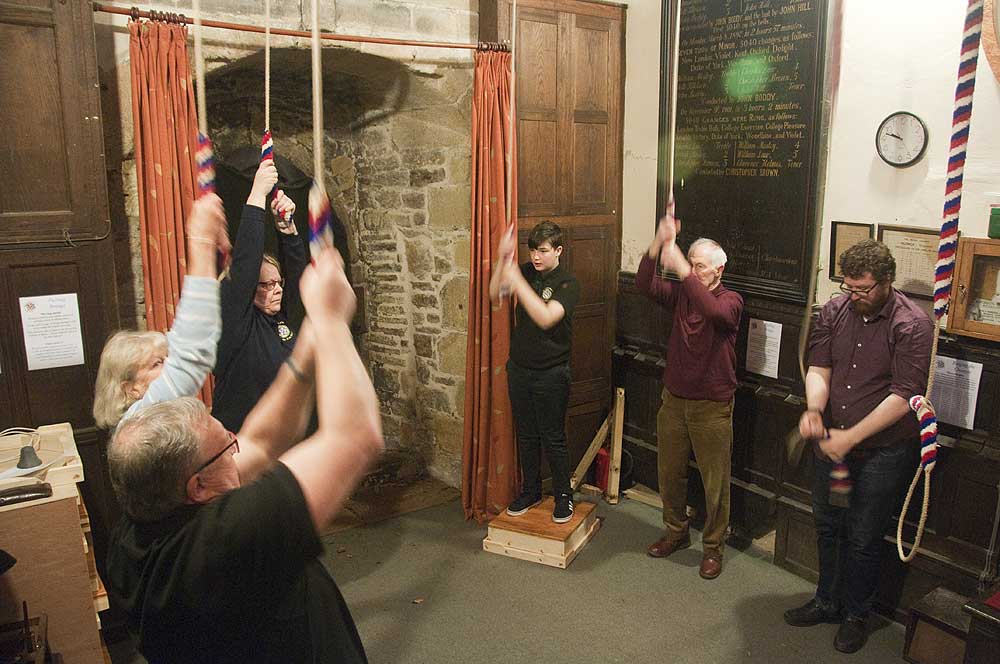Of all of the activities in church, bell ringing is, perhaps, the one that is hardest to ignore!
 There have been bells at St Andrew’s since the 1300’s and they have formed part of the soundscape of the village for some 700 years.
There have been bells at St Andrew’s since the 1300’s and they have formed part of the soundscape of the village for some 700 years.
Our current ring of eight bells was installed in 1914 and are said to be “among the best bells in Yorkshire”*. They don’t sound as loud to our neighbours as they might do because all of the sound louvres are almost totally bricked up. A sound lantern installed on the roof throws the sound out and up, so that, on a good day, they can be heard quite far afield (I’ve never heard them from my home – but that’s perhaps, because I’m not usually at home when the bells are ringing!)
* … but a lot of towers will all claim that.
Throughout the day, you will hear the clock chiming. This ancient “Cryer” clock was first built in 1709 and then renewed in 1828 by public subscription. The hour chimes were installed when the tower housed only six bells and so the chimes ring the “back six” in what is, as far as we know, a unique pattern or tune. Legend has it that when the stone lions at Kildwick Hall hear the clock strike midnight, they come down to the canal for a drink. (Trouble is, they are deaf; stone deaf!)
 Normal ringing happens for about 30 minutes before Sunday morning services and Practice Night is on Thursday evenings. Ringing starts at 7:00pm. We finish by 8:30pm.
Normal ringing happens for about 30 minutes before Sunday morning services and Practice Night is on Thursday evenings. Ringing starts at 7:00pm. We finish by 8:30pm.
Bells are also an important feature for many weddings and solemn ringing sometimes accompanies a funeral.
Other ringing does take place. Ours are fairly special and unique bells and so visiting ringers like to come (tower tours are a feature of bell ringing – “tower grabbing” is a bit like train spotting!) That’s often on a Saturday. National events, such as the death of Queen Elizabeth and the coronation of King Charles, also call for recognition.
Peals and quarter peals are sometimes rung. These are fixed length pieces that take around three hours (for a peal) or three quarters of an hour (for a “quarter peal”). Our Yorkshire tail ends mean that requests for peals are uncommon.
You are welcome!
Our ground floor ringing chamber is easily accessible to all – so come along any time we are ringing and see what we get up to. We’d love to see you!
We use the door at the West end of church.
Come and see what we do and maybe even think of joining us. We are always looking to pass on our ancient skills and passions to new ringers. You don’t have to be particularly fit or musical or mathematical. If you can learn to ride a bicycle, you have the coordination to learn to ring a bell. If you can push a child on a swing, you are strong enough to ring a bell. You probably need to have at least a “1” at the beginning of your age – but we have an enthusiastic band of ringers, ranging from primary school age up to the near-geriatric!
We occasionally hold Open Days when there is the opportunity to climb the tower and look at both the bells and our ancient clock that is still wound by hand, three times a week. Sadly, there is no safe public access onto the tower roof.
We are very aware that the bellringers at St Andrew’s are very much a part of a local community that has preserved this ancient English art for many hundreds of years.
